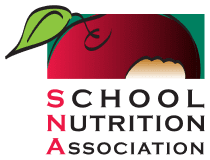Resource
How Can Schools Innovate Meal Programs to Meet New Nutrition Guidelines?
 Welcome to Season 3, Episode 3
Welcome to Season 3, Episode 3
In this episode of “School Food for Thought,” our host, Danielle Duran Baron, welcomes Patti Bilbrey, Child Nutrition Director for Scottsdale Unified School District, and Laura Bruno, CEO of Buena Vista Foods, to discuss the impact of new nutrition guidelines on school meal programs and explore innovative solutions to adapt to new guidelines. From using fast-casual dining trends to empowering students with customizable meal options, this episode will give you lots of actionable insights to help schools balance regulations with creativity. Tune in to discover how collaboration, student engagement, and community partnerships can transform school meals into something truly special.
Host: Danielle Duron Baron, MBA, CAE – VP of MarCom and Industry Relations
Speakers: Patti Bilbrey (Scottsdale Unified School District); Laura Bruno (CEO, Buena Vista Foods)
Sponsored by
Highlights from the “School Food for Thought” Podcast
Meeting new nutrition guidelines while keeping meals exciting and engaging for students is no small feat. It requires creativity, collaboration, and a deep understanding of what resonates with young diners. From reimagining classic meal options to aligning with fast-casual trends, school nutrition professionals are finding innovative ways to balance compliance with the need for appealing, nutritious meals.
In this episode, our guests and host explore how schools can empower students with choice, involve staff and community in the process, and leverage partnerships to create a dynamic and successful school meal program. The result? Meals that don’t just meet guidelines but also excite and satisfy students.
- Creativity in Menu Planning
Staying compliant with nutrition guidelines doesn’t mean sacrificing appeal. Patti highlights how schools can draw inspiration from popular fast-casual dining trends to make meals more exciting.
- Presentation Matters: Use modern serving dishes to elevate the look of meals.
- Trendy Options on a Budget: Introduce items like poke bowls with affordable substitutions like imitation crab and edamame.
- Customization Empowers Students
Laura emphasizes the importance of letting students personalize their meals. Adding flavor stations with toppings and sauces not only enhances their dining experience but also allows them to control their choices.
- Flavor Stations: Include toppings like shredded cheese or jalapeños, and let students decide what works for them.
- Sodium Control: Offer high-sodium ingredients as optional toppings to encourage mindful eating.
- Collaboration Drives Innovation
Bringing students and staff into the creative process can result in fresh, innovative ideas for school menus.
- Brainstorming with Staff: Engage foodservice managers in developing new menu items.
- Student Feedback: Create student advisory councils to test and refine meal options.
- Learning and Sharing Across Districts
Both speakers stress the value of collaboration within the school nutrition community. Networking with other districts and leveraging resources like SNA’s website can provide inspiration and save time.
- Resource Sharing: Explore successful strategies from other programs to adapt for your district.
- Manufacturer Collaboration: Partner with food manufacturers to develop creative solutions that meet student preferences.
- Building Community Partnerships
Aligning with local health initiatives can reinforce your school’s commitment to student wellness while engaging families in the process.
- Health Initiatives: Collaborate with programs like the Blue Zones project to introduce health-focused meals.
- Local Impact: Partner with organizations to create cohesive, community-centered nutrition messages.
Patti and Laura’s discussion underscores the importance of creativity, collaboration, and student engagement in navigating the complexities of new nutrition guidelines. By reimagining menus, empowering students with choices, and learning from others, schools can deliver meals that are both compliant and appealing.
Ready for more insights? Watch the full episode for actionable tips and real-world success stories to inspire your school nutrition program.



